Arbitrum – one of the most talked-about projects of 2023. The buzz is all about the highly anticipated airdrop, which marked the end of a prolonged crypto winter. Here’s why Arbitrum is significant and whether it’s worth investing in its cryptocurrency.
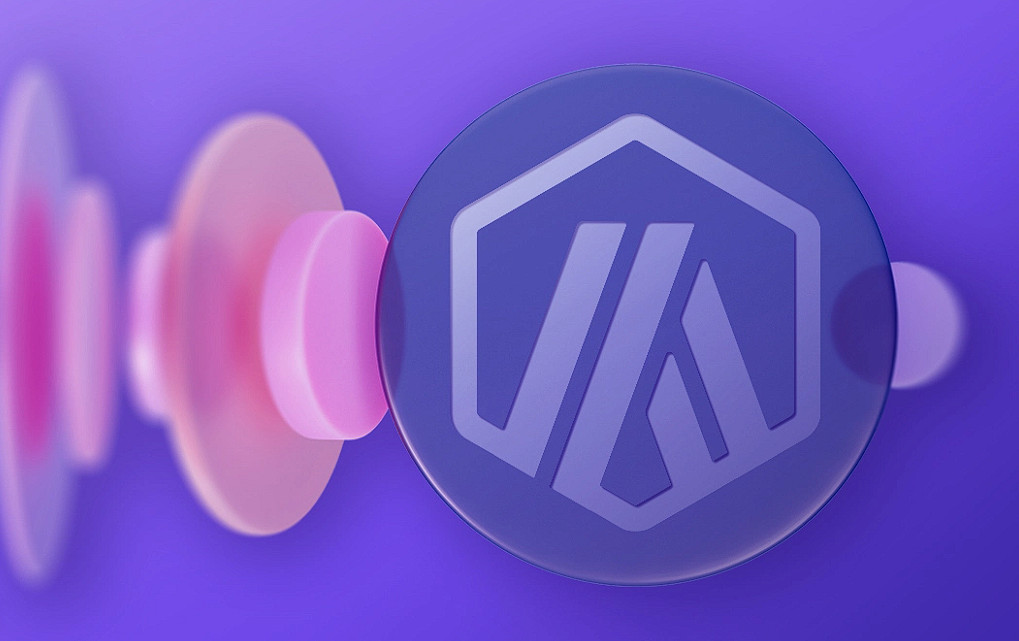
What is Arbitrum
Arbitrum is a second-layer solution for scaling the Ethereum network. Let’s delve into the terminology.
A second-layer (L2) solution is an enhancement built on top of the primary blockchain. The primary goal of L2 is to offload tasks from L1. Second-layer solutions take on some of the responsibilities of L1; for example, transactions can be conducted on L2, with the results recorded on L1. Consequently, the first-layer blockchain operates faster, and transactions become cheaper.
Ethereum is a first-layer blockchain, serving as the foundational blockchain on which other projects are built. As it became popular, it struggled to scale and cope with the growing load: buyers faced long queues, and transaction costs soared. This led to the need for L2 solutions for Ethereum.
Arbitrum is a tool that helps Ethereum process transactions more quickly and with lower fees.
Links: Arbitrum’s official website, the managing DAO’s website, Twitter, Discord, GitHub, blog.
Creation History
Arbitrum was developed by the American company Offchain Labs, founded in 2018 by three developers: former Princeton professor Ed Felten, former Google software developer Steven Goldfeder, and former Apple software developer Harry Kalodner.
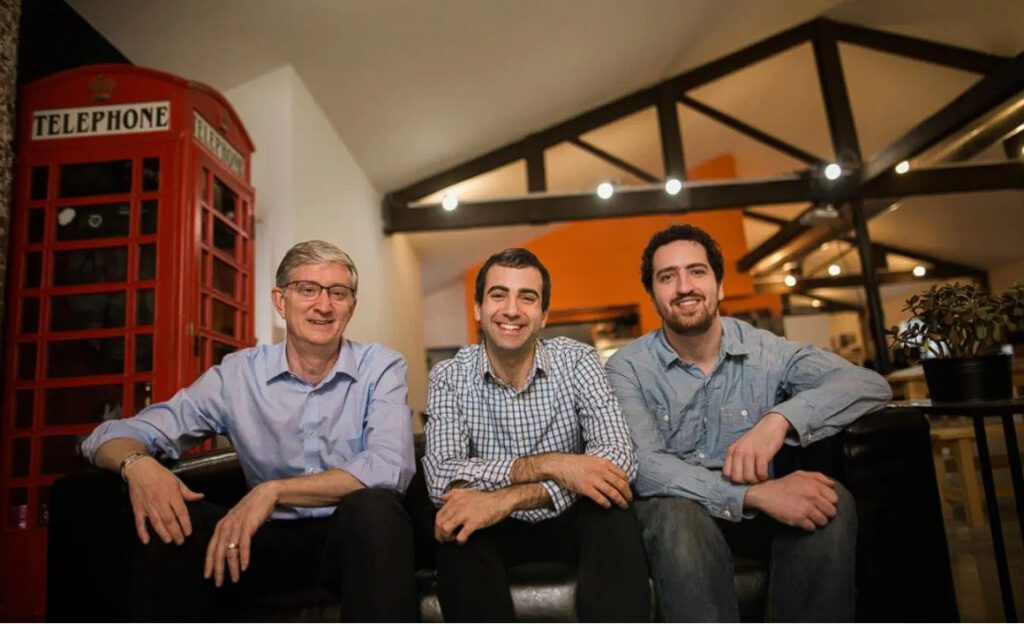
Arbitrum One was launched on September 1, 2021. At the same time, Offchain Labs announced that it had raised $120 million to develop the project from major investors such as Lightspeed Venture Partners, Polychain Capital, Ribbit Capital, Redpoint Ventures, Pantera Capital, Alameda Research, and others.
Currently, Arbitrum is governed by a decentralized autonomous organization (DAO), the Arbitrum Foundation. This means that the developers have fully transferred control of the project to its participants: all holders of ARB tokens are members of the DAO and can participate in voting on the platform’s development.
To make the voting as transparent as possible, the DAO uses tokens. Each coin represents one vote. It is registered in the system along with the address of the cryptocurrency wallet.
Imagine you bought Arbitrum tokens. A few days later, you see a proposal on the Snapshot voting platform for an upgrade of the project submitted by another user. You review the documents and decide it’s a bad idea. As a token holder and thus a DAO member, you have the right to vote against it by casting your coin in favor of your vote.
Here’s an example of a voting outcome in the Arbitrum crypto community:
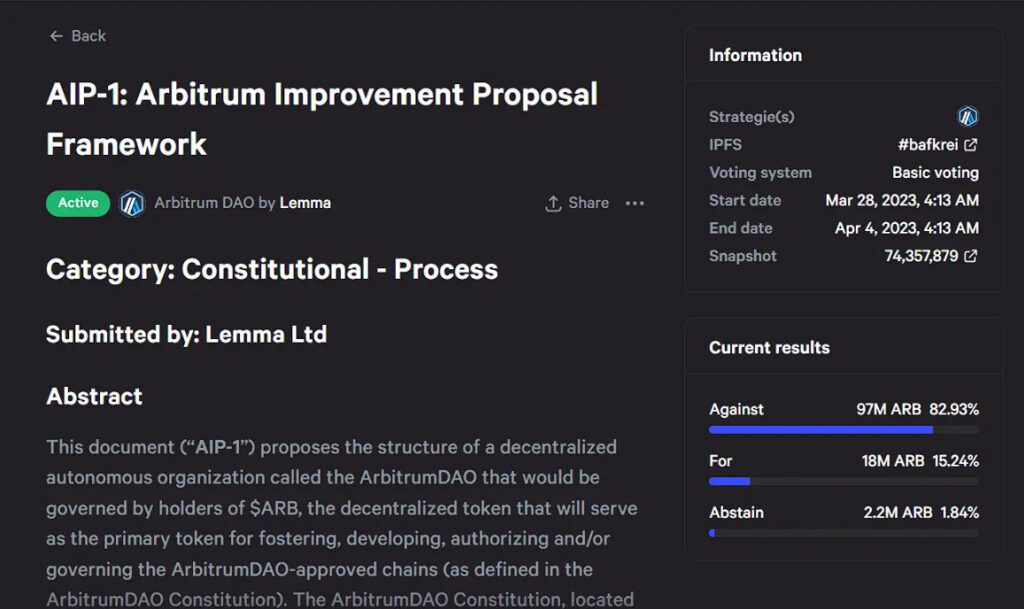
Technically, one person can register multiple cryptocurrency wallets, which means they can participate in the voting multiple times. The rules of Arbitrum do not address this situation.
How Arbitrum Works
Arbitrum is an overlay on Ethereum. This second-layer blockchain handles transaction processing, thereby unloading ETH. The Arbitrum Virtual Machine (AVM) manages data transfer between L1 and L2. It is compatible with the Ethereum Virtual Machine and supports popular programming languages such as Vyper, Solidity, Flint, YUL+, LLLL, and others.
If you want to use Arbitrum to avoid high ETH network fees and speed up asset transactions, you will need to transfer Ethereum cryptocurrency to the L2 network through a special bridge. Later, the coins can be transferred back.
At the core of Arbitrum is the development of Optimistic Rollups by the creators of the competing L2 solution, Optimism. The essence is simple: the system assumes all transactions are valid until proven otherwise. This eliminates the need for lengthy, complex, and costly analysis of each operation.
The Arbitrum team improved upon Optimism’s concept and included additional fraud protection tools in their solution, which enhanced security and helped reduce transaction fees.
On August 9, 2022, developers launched a new version of the solution – Arbitrum Nova. It differs from the first by the method of transaction confirmation: now, instead of Optimistic Rollups, the AnyTrust concept is used, making Arbitrum Nova more suitable for games and social networks.
Validators are responsible for processing transactions and bundling data for further addition to the main Ethereum network. They are system participants who have installed special software on their computers to handle network tasks. They receive rewards for their work in the form of fees.
To become a validator, you need to:
💾 Launch a node that will process transactions in the cryptocurrency network. Information on setting up the node is available [here].
🛠 Choose the type of validator and follow the instructions to set up the equipment.
There is no information in the documents about the maximum number of validators, so it is possible to join.
Arbitrum in Numbers
Arbitrum One is ranked first in the rating of L2 solutions for Ethereum by the total volume of funds locked in its network. The project accounts for more than 66% of the second-layer solutions market.
The volume of locked funds refers to the amount of assets that users have transferred to the Arbitrum network to conduct transactions on L2 instead of L1.
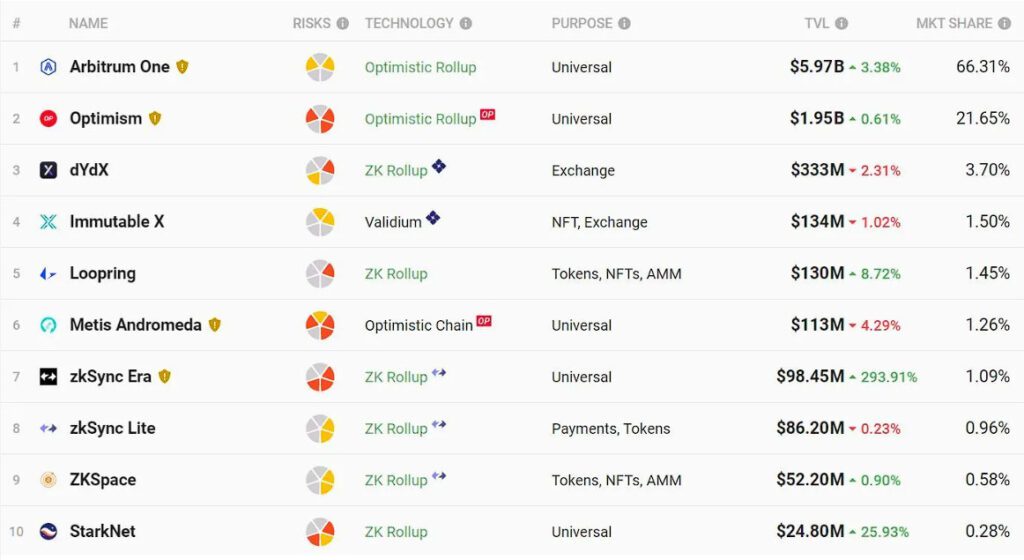
Arbitrum One is not the most cost-effective tool in the second-layer solutions market. Loopring and zkSync Lite are cheaper options. Here is a comparison of transaction costs in second-layer solution networks and Ethereum (the first column shows the cost of transferring ETH, the second shows the cost of exchanging ETH):

Here are some additional figures:
👥 Arbitrum has nearly 4 million users.
💰 Over the course of its operation, its users have saved a total of $704 million in fees.
Cryptocurrency ARB
On March 16, 2023, the developers of Arbitrum announced an airdrop of the native ARB tokens. The issuance of the coin is limited, with a total of 10 billion ARB minted, of which 12.75% were allocated for the airdrop.
Like Ethereum, Arbitrum operates on a Proof-of-Stake (PoS) algorithm, which means the cryptocurrency can be staked (earning rewards for holding tokens in an account to support network operation). ARB can be staked on two DeFi protocols: Tenderize and 0xAcid.
Initially, the airdrop was scheduled for 2022, but due to the crypto winter and the collapse of several major projects (Terra, FTX, etc.), it was postponed. By 2022, Arbitrum was already one of the largest second-layer solutions for Ethereum, so crypto enthusiasts were keenly following news about the giveaway: it was an opportunity to obtain tokens from a promising project for free. Moreover, many saw the decision of such a large platform to conduct an airdrop as a sign of the end of the crypto winter—developers usually refrain from such events in poor market conditions.
The long-awaited airdrop took place on March 23, 2023. Due to the influx of users, the Arbitrum network could not handle the traffic and went offline. Now, participants of the airdrop have six months to claim the coins they could not receive due to technical issues. There is no need to contest for the tokens—the developers have saved network snapshots at the time of the coin distribution, recording all participants.
In anticipation of the airdrop, the daily number of transactions in Arbitrum exceeded that of Ethereum (1.31 million vs. 1.07 million).
Here is how the token distribution is structured:
- 42.78% – DAO treasury (coins that the DAO can use for project development).
- 26.94% – share for developers and project advisors.
- 17.53% – share for investors.
- 11.62% – share for wallet owners on the Arbitrum network (airdrop).
- 1.13% – share for the DAO in the Arbitrum ecosystem (airdrop).
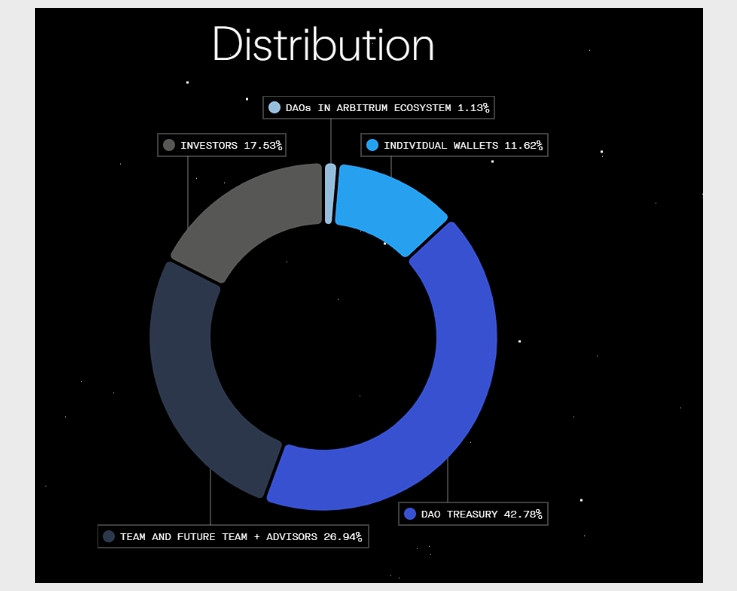
Immediately after the airdrop, the developers transferred control of the project to the DAO, meaning all token holders.
During the ARB airdrop, the token was listed on cryptocurrency exchanges. The highest value of the token was on the first day of trading at $11.80. By mid-April 2023, the coin was trading at 89.31% lower, priced at $1.30.
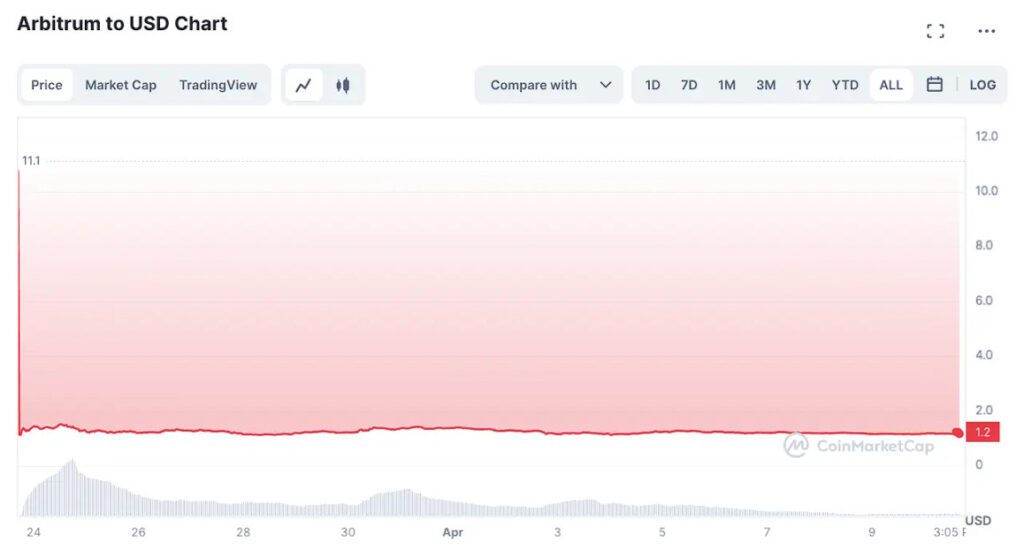
The Arbitrum project has already proven its effectiveness by breaking into the top second-layer solutions for Ethereum, making its cryptocurrency a solid candidate for investment consideration.